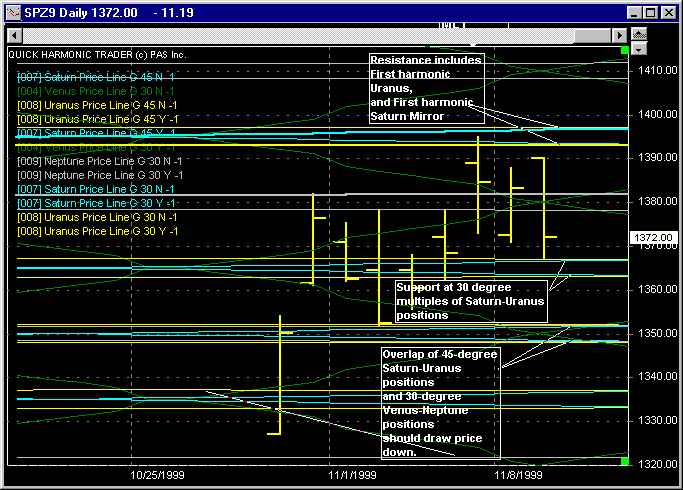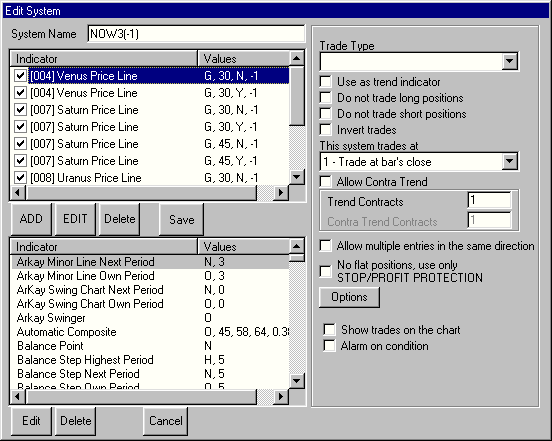Weekly Planetary System
This is a sample of what our charts look like while aspects are approaching. We apply a "System" of harmonic Planetary Lines (plots of planetary positions) at different degree settings, depending upon the aspects which are approaching. In this case, we have two critical aspects approaching, the Saturn-Uranus square, and the Venus-Neptune trine. In order to formulate our system, we use the common multiples of the aspects. So, for the Saturn-Uranus square, which is a 90 degree aspect, we will look at 30 degree and 45 degree multiples, because both are common multiples. For the Venus-Neptune trine, we will look at 30 degree multiples. (by looking at 30 degree multiples, we are also seeing 60 degree multiples, because 30 is also divisible into 60) In this way, we create a "grid" by which price is structured during the period of influence of these particular aspects. Note that we also use the mirror settings for the lines (Those with a "Y" in the parameters). The mirrors are just as valid as those which are calculated normally, when we are looking at general price action. Once you apply these systems to intraday charts, you will begin to see how price moves from "zone to zone" as it forms it's everyday patterns. Also, once you have applied systems, you will see the price levels where aspects "overlap". In this case, the zone of price from 1348.0-1350.0, which is defined by the 8th harmonic (45degree) Saturn-Uranus points, "contains" the 12th harmonic (30 degree) Venus-Neptune points at 1348.2 and 1351.8. This overlap of energy can be expected to draw the price, especially if price moves below the zone just above this area, defined by the Saturn-Uranus 12th harmonic (30 degree) points at 1363.0 and 1367.0. At the time of this writing (10:30 a.m., Nov. 10), the range of the day (not including overnight action) ranges from a low of 1363.0 to a high of 1383.0. The low was "correct" with the 12th harmonic Saturn-Uranus point, at exactly 1363.0. The high is very near the Venus-Neptune point at 1381.8.
We use the Systems section of the Galactic Trader program, or the Templates section of the Galactic Trader program to create our weekly planetary systems. We create
systems for analysis for specific time frames, and for specific harmonics, this way we can quickly project any planetary
event, in any harmonic representation, on our charts. Below is a capture of a portion of my own Systems window in the
Galactic Trader program.
Again, this is just a PORTION of the systems I use. Systems which start with G are Geocentric, and those with H are
Heliocentric. Systems which start with NOW, are specifically to show current planetary events, like the example above.
other systems, like "squares" show major square events which are happening over a longer time frame, between outer
planets. Some are systems of technical indicators, for technical analysis. It is my extensive use of systems for
analysis which has made me such a proficient user of the program. Galactic Trader users are encouraged to download and
read the latest version of the Systems tutorial from the Fibonacci Trader website. This will keep you up to date with
the functions of this part of the program. Planetary systems cannot be backtested, as technical systems can, but they
are an important part of our daily routine with the programs.
This window is an example of how this system was created in the Systems section of the Galactic Trader Program. We
simply add the lines which pertain to the multiples of the aspects which are approaching. Note that each is duplicated
with the settings of N (for non-mirror) and Y (for mirror). Since this system is for the S&P futures, we use a factor
setting of -1 for all lines. You will note in my systems window, some systems have a (-1), which indicates that they are
set up with a -1 factor. Numbers in other systems refer to the harmonic they represent. For example, G1 is a Geocentric,
first harmonic (360 degree) system. G1M would be the same system, but with mirror settings on the lines.
We will continue to post more tutorial information here for the users of our software. If you have specific questions,
please post them on the user group, and we will attempt to answer them.
Since 1992


